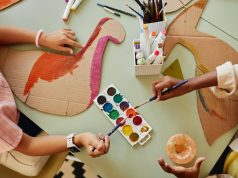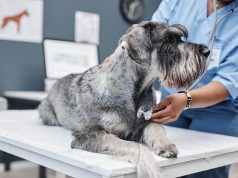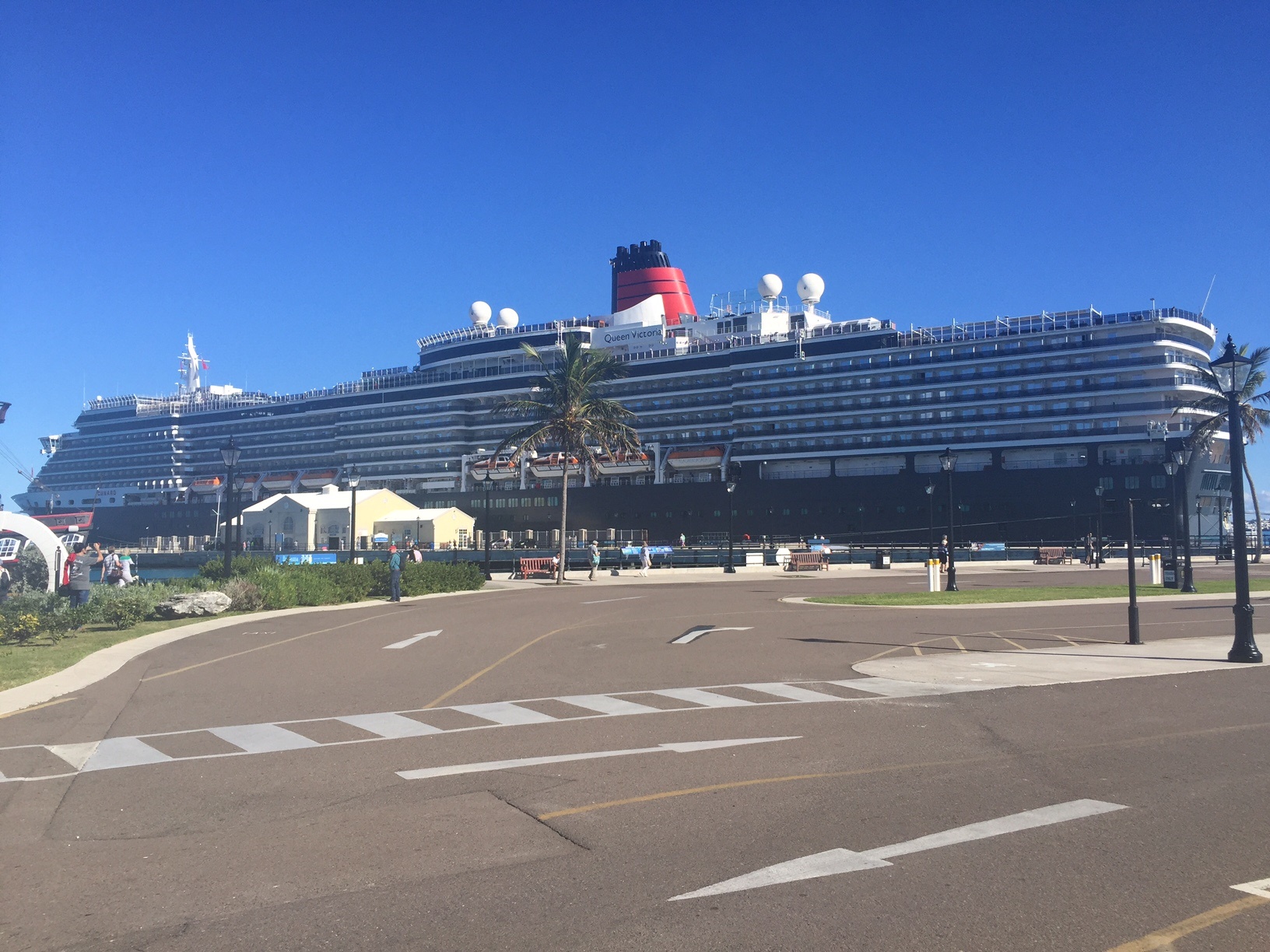
By HENRY BENDER
January 19, 2019:
Greetings,
Last night Queen Victoria entered the Devil’s Triangle, one of the busiest shipping lanes in the world. This morning the sea was calm while an eerie red glow brightened the horizon. If I wasn’t sober, I would’ve sworn the sky was on fire. Was Satan messing with us? Maybe. Not another ship was in sight. But suddenly a burst of sunshine danced my way, and I knew everything was fine. Ha! Old Lucifer, he must’ve been dozing. Thank goodness!
Later, room service came knocking. I swung open our cabin door and in marched breakfast: scrambled eggs with salmon and kippers; cranberry juice; two fruit salads; some croissants; a pecan twist; and two steaming pots of coffee. And, oh yes, a pitcher of cream.
Ah, shipboard life! As Sir Francis Drake once opined: “It isn’t that life ashore is distasteful to me. But life at sea is better.”
I couldn’t agree more. Either can my wife.
Karen and I are now 16 days into our 121-day voyage. That’s right — 121 days! We’re circling the world via the Queen Victoria. Twenty-three countries; thirty-six ports-of-call.
Our voyage began the first Thursday in January when we boarded Cunard’s Queen Mary 2 in New York, bound for Southampton, England. The passage was uneventful, though we did experience two days of Force 10 winds and heavy seas. But hey, nobody said crossing oceans would be easy. Once we arrived, we transferred to Queen Victoria, Queen Mary’s sistership, and before we were fully unpacked, fireworks lit up the sky, and our new ocean going home was underway.
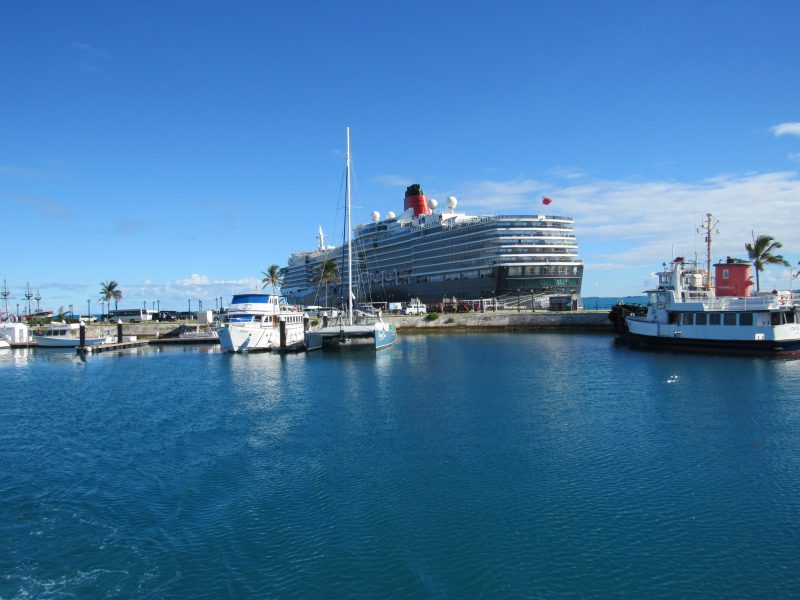
Two days ago, after sailing 3,130 nautical miles from Southampton, we stopped in Bermuda. Not long, only 6½ hours. I was on our balcony when we snuck across the surrounding reef. The pastel colored homes, the green palms, the turquoise waters, they all looked like they did 34 years ago.
In June 1985, I sailed here from Ocean City, N.J., with two of my closest friends, Bill Moffitt and Brian Kolmer. We came on the Mermaid, a 36-foot sloop belonging to Billy’s dad, Merritt. Navigating solely by compass and sextant, we rode out some harrowing seas — the trip took nearly a week. When we arrived, we anchored in St. George by the yacht club. After ten days of hell-raising we sailed home.
Queen Victoria, though, pulled into where cruise ships berth: The Royal Naval Dockyard near Hamilton, the islands’ capital. Notice, I said islands. Bermuda is actually a fishhook shaped chain of 138 islands. Most are islets. Named after Juan de Bermudez, the Spaniard who first spotted them in 1503, this archipelago is 22 miles long, a mile wide. Why the Spanish didn’t claim them remains a mystery. But they didn’t, so the English took possession in the early 1600s.
Since everyone had to be back onboard by 1530 hours (3:30 pm), Karen and I opted for a two-hour tour of colonial homes and Millionaire’s Row where Mike Douglas has a place. We boarded a double-deck motorboat named Excellence, and cruised a labyrinth of hidden waterways. Of all the Gatsby-like mansions, the house once owned by Beatle, John Lennon was my favorite. Beige and unobtrusive, it nestles the waterway with a spacious deck and dock.
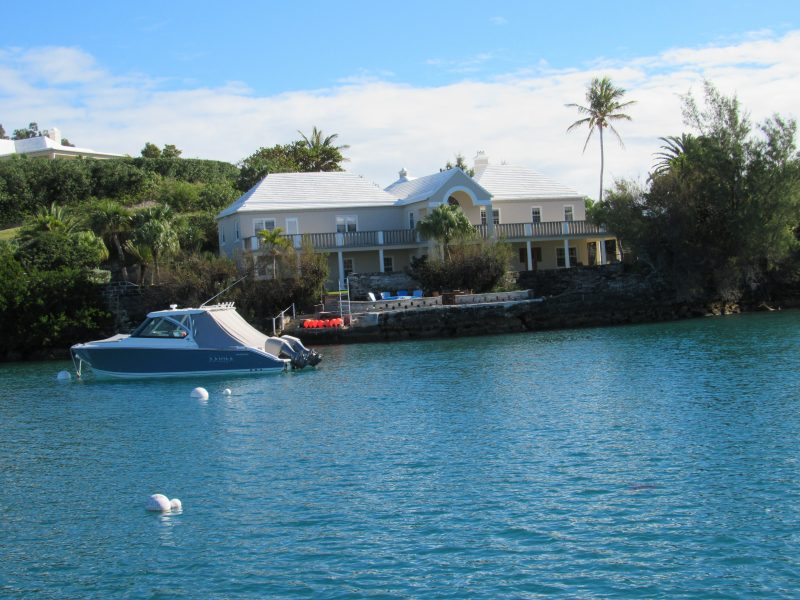
Along the way, our guide, Robert, entertained us with ribald songs — he had a terrific voice — and lots of fast facts. For instance: the Bermuda Triangle lies to the southwest of Bermuda; over 25,000 couples honeymoon here each year; a gallon of gas costs ten bucks; a Dark & Stormy is a drink — Goslings Dark rum and ginger beer; and Bermuda onions and Easter lilies are major exports. By the time we docked, I was ready for Bermudian trivia.
Of course, it would have been great to stay longer, Bermuda’s a paradise. As Mark Twain once told a local when he visited: “When you die, you’re going to heaven. When I die, I’m staying here.”
But it was time to press on. And as Queen Victoria slipped back over the reef, I told Karen again how glad I was we we’re making this trip. For so many years, circumnavigating the world had been a dream. A dream deferred, until now.
You see, eons ago in the 1960s when I was a whimsical surf rat, I became captivated by the antics of Robin Lee Graham. Dubbed “The Schoolboy Navigator” by National Geographic, Graham quit school and sailed a 24-foot sloop alone around the world. He was only 16. When he returned, he wrote a wonderful book titled DOVE (the name of his boat) about his five-year voyage. After reading it, I was psyched to sail the world.
But I never did, even though I’ve owned two ocean going sailboats since graduating high school. That was forty-nine years ago. And now that I’ve reached the age of metal — silver in my hair, gold in my teeth, and lead in my butt — I’m pretty certain I never will. Torn rotator cuffs, bad knees, a kinky back are my new normal. Besides, Karen suffers Parkinson’s, so yeah, she’s slower than the average bear.
But that’s all okay. Having a spot of tea in the Queen’s Room while listening to pianist Luke Faulkner tickle the ivories, as white gloved waiters in white jackets serve finger sandwiches is, really, much nicer than adjusting sails in 15-foot seas. And, having our steward, Ben, make up our bed every morning, then turn it down at night is a treat, too. Every evening he leaves two Godiva chocolates.
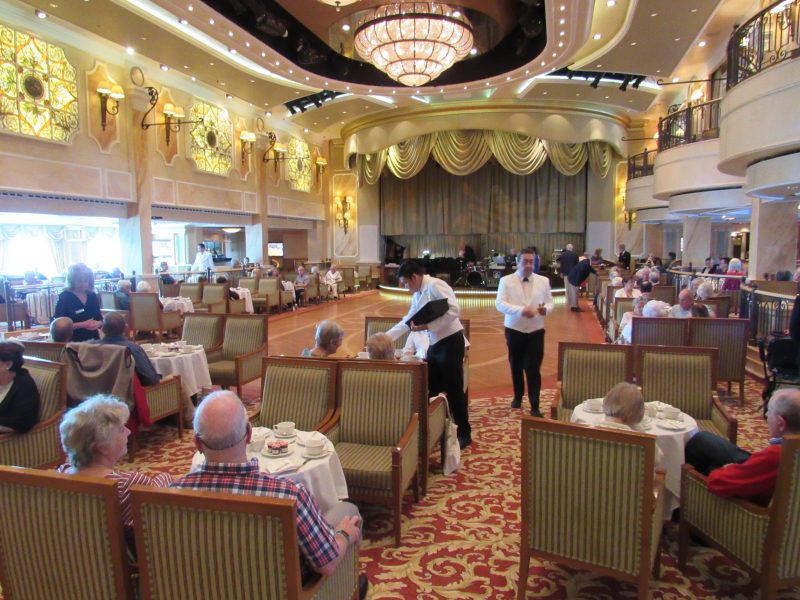
At dinner we have our own table in the Britannia Restaurant. And it’s not galloping like a stallion. Linen table cloth, napkins, polished silverware — it’s like dining at the Plaza in New York. And the meals, well, they’re to die for.
Evenings, instead of keeping a head’s up for other boats, we enjoy shows. Four nights ago, in the Royal Court Theatre, Mr. Entertainment, Philip Browne took us on a musical journey, singing songs by Paul Robeson, Nat King Cole, Elton John, and Lionel Richie.
And two nights ago, we saw A Stroke of Genius, an eclectic show that paired world-famous artists and their works with popular music: Imagine Andy Warhol with the Rolling Stones. It was a hoot!
Tonight, we’ll arrive in Port Canaveral, Florida. Monday we’ll hit Ft. Lauderdale, then we’re off to Aruba and Cartagena, Columbia, before cutting through the Panama Canal.
Since beginning this trip, Karen and I have crossed the Atlantic twice. And, since joining Queen Victoria, we’ve traveled over 4,200 nautical miles, almost one fifth of the world’s circumference. We’ve crossed, too, the Mid-Atlantic ridge — the longest mountain range in the world — and have passed over depths that reach several miles. We’ve also experienced heavy winds and seas, but nothing troublesome.
I should mention, too, that we’ve attended several gala balls; and two swanky cocktail parties hosted by our captain, Andrew Hall. As the Brits say, they’ve been quite lovely. I mean, dressing up in a tux sure beats wearing damp, smelly, foul-weather gear any day.
Anyhow, what the next three months has in store for us is difficult to imagine. So, Karen and I don’t think about it. Instead, we’re just willing to embrace whatever comes our way. As Tennessee Williams so astutely observed: “Life is all memory except for the one present moment that goes by you so quickly you hardly catch it going.”
My friends, look for another letter sometime in February. I’ll share with you those moments we’re catching.

Editor’s note: Henry Bender, of Ocean City, is a retired Ocean City High School English teacher turned full-time writer and global traveler. His seashore-themed book, “Stirring the Dust,” is a compilation of his articles and columns that appeared in newspapers and other publications. Accompanied by his wife, Karen, he is writing a first-hand account of his around-the-world cruise aboard the Queen Victoria for MediaWize/SomersPoint.com. This is the first of five articles.


